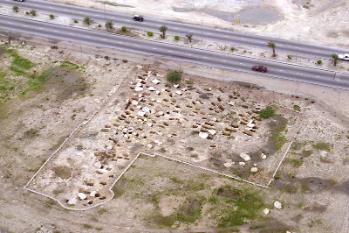Contact Center
.
Al-Hajar Dilmun and Tylos Cemeteries
Al-Hajjar site, mainly explored and studied by the Bahrain Department of Antiquities in 1970-71, was also excavated episodically in the mid-1990s by Bahraini archaeologists. This extensive archaeological site revealed a major ancient cemetery, covering an occupation period from the Bronze Age, c. 2000 BCE, down the Tylos period, which extends in the first centuries of our era. The southern part of the site contains several Tylos period burial mounds, still unexcavated, but Al-Hajjar is more famous for its northern complex of rock-cut graves, situated just at the edge of the present Budaiyah Highway. These underground burials are rare in Bahrain. At Al-Hajjar they were used during the Early Dilmun period (c. 2000-1800 BCE), the Middle Dilmun period, when Bahrain was incorporated into the Mesopotamian Kassite kingdom (c. 1400-1300 BCE), the Late Dilmun Period (c. 900-800 BCE), and the Hellenistic/Parthian periods, when Bahrain was called Tylos (c. 200 BCE to 300 CE).
It is still difficult to establish if all the graves were built in the Early Dilmun phase and re-used later or if the inhabitants of the mid-2nd millennium and 1st millennium BCE built their own burial structures. Some are still covered with flat capstones. This northern cemetery yielded numerous artefacts from these various periods. One collection of Late Dilmun burial offerings is notably on display at the Bahrain National Museum, including several masterpieces of pottery, soft stone and alabaster vessels, stamp and cylinder seals. Interestingly, the first Early Dilmun stamp seal deposited in a grave was discovered there in 1970, close to the neck of a human skeleton. The Tylos burials found at Al-Hajjar and nearby also yielded numerous complete pottery and fine glass vessels, iron weapons, jewellery items and two limestone statues which, up to now, remain unique in Bahrain.










